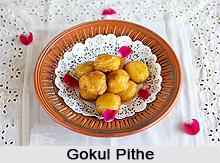 Gokul Pitha is a traditional Bengali dessert. This is prepared during "Makar Sankranti" or "Poush Sankranti" along with "Puli Pitha" or "Bhapa Pitha", "Dudh Puli" and "Patishapta". Like most of the Sankranti desserts, Gokul pitha is prepared with a stuffing of grated coconut and as these are kept in sugar syrup for some time. As a result, Gokul Pitha becomes very soft and melts in the mouth with all its sweetness
Gokul Pitha is a traditional Bengali dessert. This is prepared during "Makar Sankranti" or "Poush Sankranti" along with "Puli Pitha" or "Bhapa Pitha", "Dudh Puli" and "Patishapta". Like most of the Sankranti desserts, Gokul pitha is prepared with a stuffing of grated coconut and as these are kept in sugar syrup for some time. As a result, Gokul Pitha becomes very soft and melts in the mouth with all its sweetness
Poush Sankranti or Bengal"s very own harvest festival is a very traditional one. Focusing on the season"s bounty, the freshly harvested paddy, coconut and date palm jaggery the food loving Bengalis prepare finger-licking delicacies called "Pithe Puli". But before that a "Neivedya" (food offering to God) is prepared with unboiled rice, banana, jaggery, coconut and milk as an offering to the Goddess Lakshmi for blessing us with good harvest.
Ingredients:
•Khoya - 1 cup
•Grated coconut - 1 and half cup
•Dates jaggery - 1/4 cup
•Flour - 1 cup
•Milk - 1 cup
•Ghee - 1 tsp
•Soda-bi-carb - 1/2 tsp
•Oil for frying
Ingredients for Syrup:
•Sugar - 2 cups
•Water - 4 cups
Method:
1. First make sugar syrup by heating 2 cups sugar with 4 cups of water in a heavy bottomed vessel. Simmer until syrup gets a medium thick consistency. Remove from the flame and allow it to cool.
2. To prepare filling, fry the coconut, khoya and 2 tbsp of sugar together in a pan over medium flame. Stir continuously to avoid the filling getting stuck at the bottom of the pan. Turn off the flame.
3. To make cakes, divide the coconut-khoya mixture into equal portions. Roll them into balls and flatten between the palms to form the cakes. Powder palms with flour for ease in forming the cakes.
4. Now make the batter by mixing flour, remaining water, sodium bi carbonate and a little ghee together.
5. Heat ghee in a pan and coat coconut-milk cakes in the prepared batter.
6. Deep fry until a rich golden brown colour. Remove cakes from the pan with slotted spoon.
7. Drain excess oil on paper and while still hot, immerse the cakes in the sugar syrup.




















